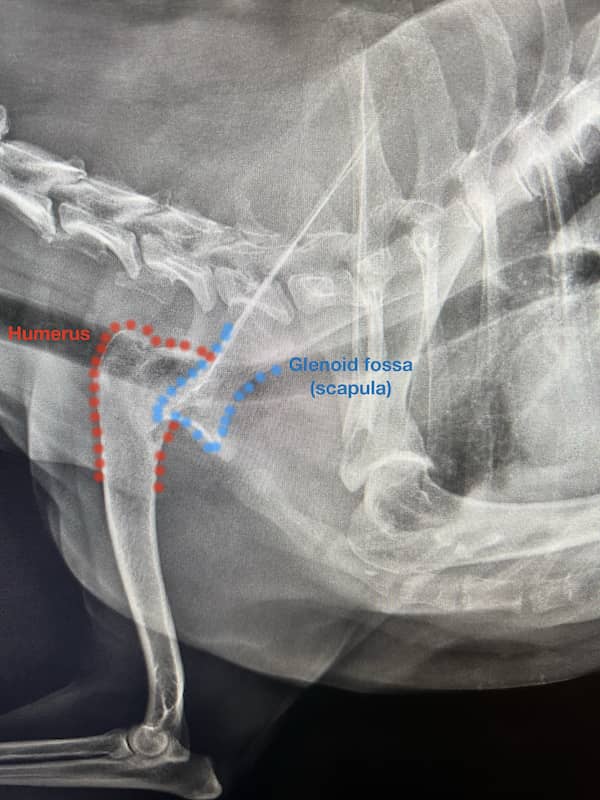If your dog is suddenly having difficulty using one of its front legs, it may be experiencing shoulder dislocation. Shoulder dislocation in dogs, which is also known as shoulder luxation or subluxation, occurs when the shoulder joint becomes unstable and the humeral head pops out of the glenoid fossa. There are a few causes for shoulder dislocations in dogs, but the most common are trauma and congenital malformation of the shoulder joint. Treatment depends on the cause and severity of the injury but often involves surgery or supportive therapy. In this article, we will discuss the causes and treatment options for shoulder dislocation in dogs.
What is shoulder dislocation in dogs?
Shoulder dislocation in dogs is a condition where the dog's shoulder joint (glenohumeral joint) luxates or becomes subluxated. The shoulder joint is a ball-and-socket joint, and the socket is deepened by a lip of bone called the glenoid fossa of the scapula. In a normal shoulder, the ball (the head of the humerus) fits snugly into this socket. However, in a dislocated shoulder, the head of the humerus luxates out of the glenoid fossa and becomes displaced. Shoulder joint dislocation means that the humeral head has completely come out of place with the glenoid fossa. Subluxation is when there is a displacement of the humeral head, but it's not fully luxated.
Causes of shoulder dislocation in dogs
Shoulder luxation and subluxation are often caused by trauma or congenital malformation of the shoulder (glenohumeral) joint, especially flattening of the glenoid fossa of the scapula. Congenital shoulder luxation is most common in small breed dogs. The dachshund, Chihuahua, Pekinese, Shetland sheepdog, and toy poodle are all susceptible breeds to congenital shoulder dislocation.
Symptoms of shoulder dislocation in dogs
Some common symptoms of shoulder dislocation in dogs include lameness, swelling, and pain. If you suspect your dog has a shoulder dislocation, it is important to seek veterinary attention right away.
Treatment options for a shoulder dislocation in dogs
If you want to increase the chances of a successful outcome, it is important to diagnose, reduce, and stabilize the luxated joint as soon as possible, regardless of the treatment method.
Closed reduction
This is often the first step in treating shoulder dislocation in dogs. This is a procedure where the veterinarian manually puts the humeral head back into place within the glenoid fossa. Once closed reduction is successful, your dog will need to be immobilized for four to six weeks while the shoulder joint heals. Various slings can be used to support and immobilize the shoulder such as a Velpeau or spica splints.
Surgical repair
The shoulder joint often requires surgery if it remains unstable after closed reduction, if luxation returns while the leg is in a sling, or if it is chronic. Depending on the type of luxation present, different techniques have been used to surgically stabilize the shoulder joint.
Caudomedial transposition of the tendon is the most common procedure for shoulder luxation. By placing a small plate over the tendon and groove, a bone screw and spiked washer hold the tendon in place.
Congenital shoulder luxations
Congenital luxations discovered later in life are usually irreversible due to severe malformations of both the scapular glenoid and humeral head. Closed reductions are typically ineffective. Although the above surgical techniques can be attempted, if the glenoid is deformed/remodeled, or if the joint has degenerative joint disease, surgical stabilization is usually unsuccessful. The treatment in these cases requires excisional arthroplasty of the humeral head and/or glenoid fossa, as well as an arthrodesis.
Supportive therapy
Analgesics such as nonsteroidal anti-inflammatory drugs (NSAIDs) are used to control any pain and discomfort. Rehabilitation physical therapy is an effective tool for enhancing healing and recovery during conservative management and after surgery.
Prognosis for shoulder dislocation in dogs
With either conservative or surgical therapy, most dogs with traumatic luxations that were treated in the acute stage of luxation achieved full functional recovery. Dogs who undergo excisional arthroplasty or arthrodesis have a poor prognosis for a full recovery. In most cases, these dogs will have permanently low mobility and abnormal gait.
In summary, shoulder dislocation in dogs can be caused by trauma or congenital malformation of the shoulder joint. If left untreated, shoulder dislocation can cause lameness, swelling, and pain. There are a variety of treatment options available, depending on the severity of the dislocation. With early diagnosis and treatment, most dogs make a full recovery. If you have any further questions or are concerned about shoulder dislocation in your dog, please contact your veterinarian for further advice.




